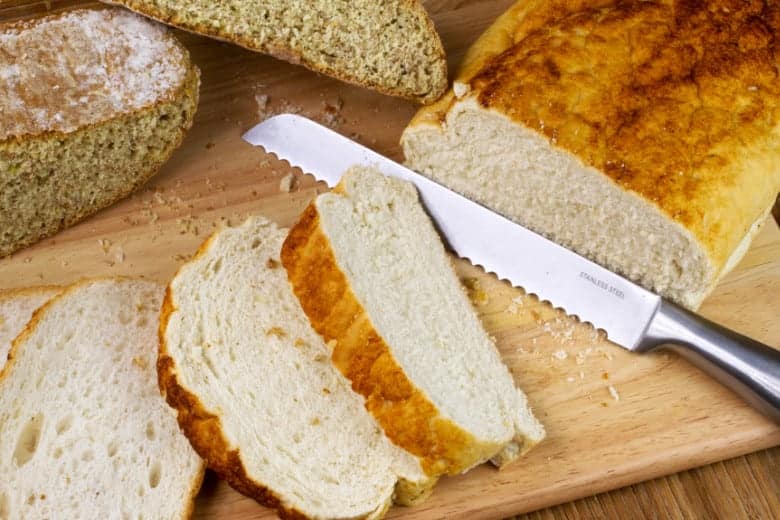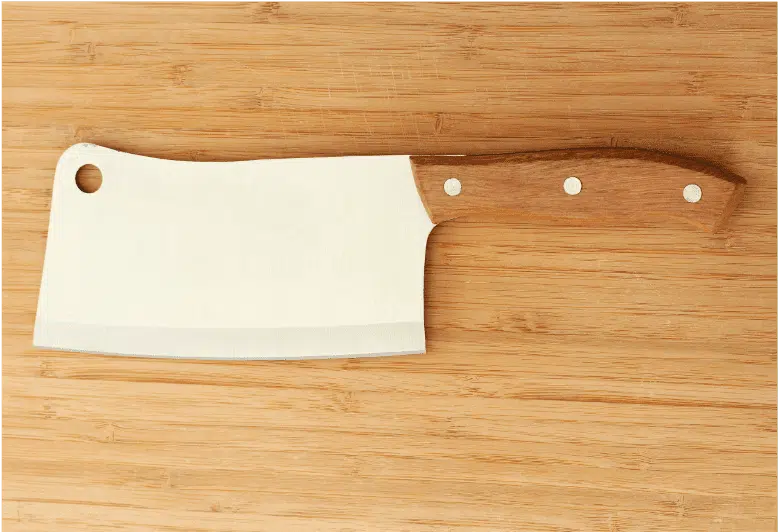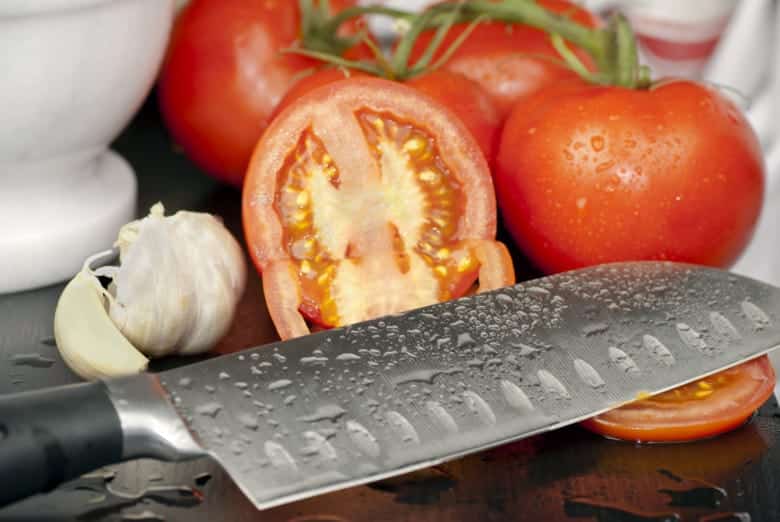There are two things that drive me crazy when cooking, clutter and dull knives. In today’s article, I’ll be focused on the latter. Using a sharp, high-quality knife can turn drudgery into an enjoyable task, at least on a pleasant, Sunday afternoon.
I have assembled a collection of the best German knives from the top manufacturers. After reviewing dozens of kitchen knives, in my opinion, the Wüsthof Classic IKON 8-Inch Chef’s Knife is the ultimate winner. An 8-inch chef knife is a must-have in everyone’s kitchen and the Wüsthof has the build quality, ergonomics, and durability that will last for years.
Continue reading to discover the perfect knife for your kitchen tasks from this wide selection.
Best Chef’s Knife: Wüsthof Classic IKON 8-Inch Chef’s Knife
The Wüsthof Classic IKON 8-Inch Chef’s Knife is a perfect all-around kitchen knife. Like any good chef knife, it’s ideal for mincing, cutting, and chopping vegetables, fruit, meat, and fish.
Weight is an important factor for any chef’s knife, and this model is ideal for those searching for a lightweight knife. Since the half bolster (junction between the handle and blade) reduces its overall weight, you can handle it with ease while reducing fatigue.
If you’re anything like me, you don’t enjoy or even remember to sharpen your chef’s knife; the job can be boring, difficult, and even dangerous. Fortunately, this knife’s design allows you to sharpen it easily.
Due to its timeless design, you’ll want to keep this chef’s knife on display in your kitchen. This is all thanks to its sleek black handle, which feels good in your hand and provides plenty of control.
Finally, with an eight-inch blade, this is the perfect length to cut cabbage, long-stem broccoli, and other larger ingredients. I dislike knives with blades that are too short because it can make prep time longer and more strenuous.
Pros
- Lightweight design makes it easy to handle
- Exceptional quality
- Forged from a single piece of steel
- Easy to sharpen
Cons
- Expensive
Best Knife Set: J.A. Henckels Premium 15-Piece Knife Set With Block
Here at Kitchenda, the J.A. Henckels Premium 15-Piece Knife Set With Block is a favorite for prepping food and solving a kitchen storage solution.
This 15-piece set makes it perfect for beginner cooks who are just starting their culinary adventures. With one purchase, you’ll have every cutting tool you’ll ever need (cleaver?).
Chopping ingredients can be tiring, which is why I appreciate that each knife in this collection has an exceptionally sharp blade for precision slicing. The hollow edge santoku knives have blades with tiny depressions along the side, that keep food from sticking. Perfect for slicing carrots or mincing garlic.
Constructed from single-piece, stamped stainless steel, the blades are lighter than forged knives. This offers optimum mobility together with the full tang for strength. Curved triple-rivet handles with a stainless-steel endcap enhance balance and comfort while also adding visual appeal.
Set includes:
- 3-inch paring knife
- 5-inch serrated utility knife
- 5-inch hollow edge santoku
- 7-inch hollow edge santoku
- 8-inch chef’s knife
- 8-inch bread knife
- 6 x 4.5-inch steak knives
- Sharpening steel
- Kitchen shears
- Hardwood block
Pros
- Includes a large variety of tools
- Fine-edge blades for precision cutting
- Long-lasting sharpness
- Inexpensive
Cons
- Block could be fancier
Best Bread Knife: Zwilling Twin Signature 8-Inch Bread Knife
Despite what its name suggests, a bread knife is actually useful for so much more than just bread. With the Zwilling Twin Signature 8-Inch Bread Knife, you can make quick work of cakes, bagels, tomatoes, melons, pineapples, you name it. Any job that requires a serrated blade is perfect for this knife.
If you’re tired of your knives corroding and having to replace them every couple of years, you’ll appreciate how long-lasting this eight-inch bread knife is. Designed from a single piece of German steel, it’s lightweight, durable, and sharp enough to cut through anything you put it to.
It’s stain and chip-resistant. That’s a huge bonus, although most bread knives aren’t exposed to tough materials anyway.
Meanwhile, this bread knife features an ergonomic handle. This is essential to increase precision and improve your safety when cutting. In particular, the handle’s curved shape provides a firm grip to maximize control and comfort.
Pros
- Corrosion-resistant
- Cuts through thick loaves easily
- One-piece blade for a lightweight design that’s durable
Cons
- Might need to be sharpened regularly
- Some larger artisanal bread might need a 10-inch knife
Best Budget Chef’s Knife: Victorinox Fibrox Pro 8-Inch Chef’s Knife
The Victorinox Fibrox Pro 8-Inch Chef’s Knife is built for any chef (of all levels) looking for a durable kitchen accessory at an irresistible price. It’s constructed of stainless steel for incredible sharpness and strength, with a thermoplastic Elastomer, ergonomic non-slip handle.
Meanwhile, its lightweight form is everything I look for. This is because a lighter knife is less strenuous on your wrists and the design offers superior balance.
For the price, this is one of the best German knives for chopping and mincing smaller ingredients, such as onions, shallots, garlic, and herbs.
Pros
- Retains sharpness for a long time
- Inexpensive
- Lightweight design makes it easier to hold if you have weaker wrists
- Handle has a non-slip material for maximum safety and control
Cons
- Some might prefer a heavier knife
Best Utility Knife: Cutluxe 5.5-Inch Utility Knife
Consider the Cutluxe 5.5-Inch Utility Knife if you’re looking for a great all-around knife with a razor-sharp edge. It’s perfectly tapered to slice vegetables with ease. This is perfect for cutting through rounded food, like tomatoes, without the juices spraying everywhere. In fact, it has a hand-sharpened edge at 14–16 degrees on each side for incredible edge retention and sharpness.
A good kitchen utility knife fills the gap between your chef and your paring knife. At 5.5 inches the Cutluxe is perfectly sized to handle just about any task from mincing garlic or shallots, peeling fruit, and slicing meat, cheese, or sandwiches. If you’re tight on space or have limited funds, a good utility knife can replace many of the more specialized knives in your kitchen. It’s that flexible.
Another characteristic that I love about this German knife is its triple-riveted, pakkawood handle. Not only does it look great but the handle is resistant to water, heat, warping, or splitting.
Moreover, this utility knife won’t break apart at the first sign of a hardened ingredient. And it certainly won’t dull quickly, either. Best of all, this kitchen knife has been forged using high-carbon German steel to withstand daily use. And it’s also rust- and stain-resistant.
Pros
- Razor-sharp edge cuts through ingredients with ease
- Ergonomic handle for maximum comfort and durability
- Inexpensive
- Full tang for increased strength
Cons
- Handle might be bigger than some people are used to
- Made in China
Best Filleting Knife: Hammer Stahl 7-Inch Fillet Knife
The Hammer Stahl 7-Inch Fillet Knife is thin and flexible, providing all the precision and ease you need when filleting fish. In particular, its narrow blade moves evenly along bones to effortlessly separate the flesh.
The blade’s pointed tip allows you to cut with precision and in one single stroke.
Furthermore, this fillet knife won’t let you down, and you won’t have to replace it every couple of years. Built with German-forged stainless steel, it will last you years and provide a sharp edge every single time you use it.
This knife is simply beautiful to look at, too, which helps to make prep work a little less daunting. With a pakkawood and steel quad-tang handle, it offers incredible balance and comfort.
Pros
- Blade moves precisely and smoothly along the skin
- German-forged stainless steel provides long-lasting durability
- Beautiful design
Cons
- A bit on the heavy side
- Made in China
Best Nakiri: Wüsthof Classic IKON 7-Inch Nakiri Knife
It wouldn’t be right if I didn’t include the Wüsthof Classic IKON 7-Inch Nakiri Knife in this article on the best German knives.
For those unfamiliar with the Nakiri, it’s basically a Japanese mini-cleaver specifically designed for chopping, mincing, and slicing vegetables and fruits. Also, its blade helps to achieve wafer-thin cuts every time, which is great if you’re a perfectionist like me.
Designed with an exceptionally thin blade, a 10-degree cutting edge, and Precision Edge Technology. This precision-forged, carbon stainless steel blade is 20% sharper than previous Wüsthof models.
The side of the blade is designed with vertical indentations, called a Granton edge, which forms air pockets that help keep sliced veggies from sticking to the blade.
Wüsthof’s Classic IKON series is top of the line and doesn’t come cheap, and the Nakiri is no exception. But, if properly maintained, it will last a lifetime. To me, it’s worth every penny.
Pros
- Extraordinary materials and construction
- Achieves wafer-thin cuts
- Incredibly sharp for excellent precision
Cons
- Expensive
Related: Best Japanese Knives For Your Kitchen. A Buyer’s Guide
What to Look for When Buying the Best German Knives
Before you plunge into buying German kitchen knives, there are some important factors you’ll want to consider first. To make things easier for you, here’s a breakdown of the top features to consider. Here’s a great guide just in case you aren’t familiar with all the terms.
Types of Knives
There’s no shortage of specialized knives for the kitchen. Here’s a breakdown of the most common types.
Chef Knife
I recommended considering a chef knife if you’re looking for an all-purpose, versatile kitchen accessory. Available with a blade length from 8–12 inches, chef knives are deep and curved to allow you to use them for a variety of prepping. This means you can chop onions, vegetables, fruits, and meat with just one knife.
Utility Knife
This type of knife is smaller than a chef knife and has a narrow, precise blade that’s ideal for peeling, carving, and slicing vegetables and fruits. Typically available in lengths of 4-9 inches.
Paring Knife
These range from 2.5–4 inches long and are perfect for simple tasks like peeling and cutting vegetables and fruits. They also have a sharp tip for incredible precision. Perfect for more delicate work.
Bread Knife
These knives have long, straight blades with a serrated edge that lets you cut through fresh bread, thick bagels, cake, and other bakery goods. The jagged blade means you can slice bread in one attempt without crushing them out of shape.

Carving Knife
A carving knife tends to be long and narrow to minimize drag as you cut through food. This will produce cleaner, more consistent slices. Carving knives range from 8–12 inches.
Steak Knife
Finally, a steak knife’s blade typically measures 4.5 inches. These knives also feature a fine edge to cut through thick chunks of steak with ease.
Boning Knife
A boning knife’s characteristics include a sharp tip and narrow blade. This design makes it easier to remove flesh from fish and poultry. You can even separate meat from bones. Boning knives range from 3–6 inches.
Filleting Knife
Similar to a boning knife but with a thinner, more flexible blade, a filleting knife is specifically designed for fish. It’s perfect for the intricate work of separating bones from the delicate flesh.
Cleaver
A cleaver is all about chopping. The heavy, rectangular blade is designed for cutting through thick cuts of meat, joints, and even bone. It will also make quick work of tougher vegetables like squash or sweet potatoes. Sure, it looks scary (stop watching all those horror movies!) but it can really come in handy for chefs that work with lots of meat and poultry. I’m talking to you barbeque pitmasters!

Santoku
A great alternative to a chef knife, the santoku’s straight edges and drop-point tip make them an effective tool for precise cutting, mincing, and dicing. After cutting, the broad blade can be used for gathering up and moving food to pans or containers.
Nakiri
Resembling a cross between a chef knife and a cleaver, the nakiri is intended strictly for vegetables. Instead of rocking the blade as you would with a chef knife, you use a single chopping motion instead. Like the santoku, it can also be used to scoop up and move diced or chopped veggies.
Handle Design
German knives feature a variety of handles. Here are some to look out for to help choose the best one for you.
Full Bolster
These handles are the best to prevent your fingers from slipping. This makes them perfect for people with weak wrists or those generally looking for more support when cutting ingredients.
However, a downside of full bolster knives is that you won’t be able to use the blade’s entire length, which means you might also encounter some difficulties with sharpening the knife.
Half Bolster
You might want to consider these knives if you want to be able to use the blade’s full length. They also minimize slips to protect your fingers when you chop ingredients.
No Bolster
Finally, these knives might not be suitable if you’re looking for durability and strength. With that being said, you can use the entire length of these kitchen knives, and they’re easy to sharpen.
Handle Material
Look into the features of these materials for a handle.
Wood
Avoid a wood handle because it’s a breeding ground for bacteria and won’t last long. However, one benefit of a wood handle is the comfort they provide, though they don’t tend to be moisture-resistant and typically warp. The one exception is pakkawood which is really a combination of wood and resin.
Stainless Steel
Highly durable and relatively easy to maintain, a stainless steel handle is easy to care for and will last years. However, I don’t recommend this material if you’re a beginner since it can be very slippery if wet, increasing your chances of injury.
Plastic
Finally, a plastic handle offers a slip-resistant grip and is dishwasher safe. However, it can be less durable than stainless steel and wood, since it’s easier to mark this material.
Weight
A heavier knife will offer more stability than a lighter one. The additional weight also makes cutting easier, since you can use the weight to help apply more force.
However, you might prefer a lighter knife if you’re a beginner and are looking for more control and dexterity.
Blade Material
The most important aspect of a knife is the blade’s material. German knives use high-carbon stainless steel for plenty of durability and to maintain a sharp edge. This material is also corrosion and stain-resistant.

What Are the Benefits of German Knives?
Why have I chosen to only recommend German knives in this article? That’s because they have a host of benefits.
Thick, Heavy Blade
Typically, German knives have a thick blade and bolster, and the knife blade widens to add weight and improve the knife’s overall balance. This helps to give you more control as well as protect your hand from a sharp blade.
Furthermore, a weighty blade provides robustness, making it more durable.
Durable Construction
German knives are known for their durability, as they have a full tang construction, meaning that the steel runs from the blade right to down to the base of the handle. Overall, this helps to improve the design for increased efficiency.
Comfortable Handle
Never neglect a knife’s handle. Not all brands use the same material, and some are heavier than others. But, generally speaking, the best German knives have an ergonomic handle to maximize comfort and retain a safe grip.
German Vs Japanese
German knives are renowned for being strong, resilient, and adaptable. They are excellent all-purpose knives that can handle a wide variety of ingredients and cooking techniques. German knives often have softer steel, which means their blades last longer but do not maintain their edge as well.
Japanese blades are known for being light and precise. They often use harder steel, which makes them more brittle and prone to breaking over time. However, compared to German blades, Japanese blades tend to hold their edge longer.
Related: Kitchen Knife Buyer’s Guide: Tips For The Perfect Choice
Which Is the Best German Knife?
While I can’t select the best German knife for every individual, I can confidently say the Wüsthof Classic IKON 8-Inch Chef’s Knife is my personal favorite. Yes, it’s expensive but it just has a feel and look that screams quality. It’s hard to get that across without actually holding it in your hands but it’s there! Just ask any professional chef.
If you like quality tools that last a lifetime, check out the Wüsthof Classic IKON 8-Inch Chef’s Knife today.







